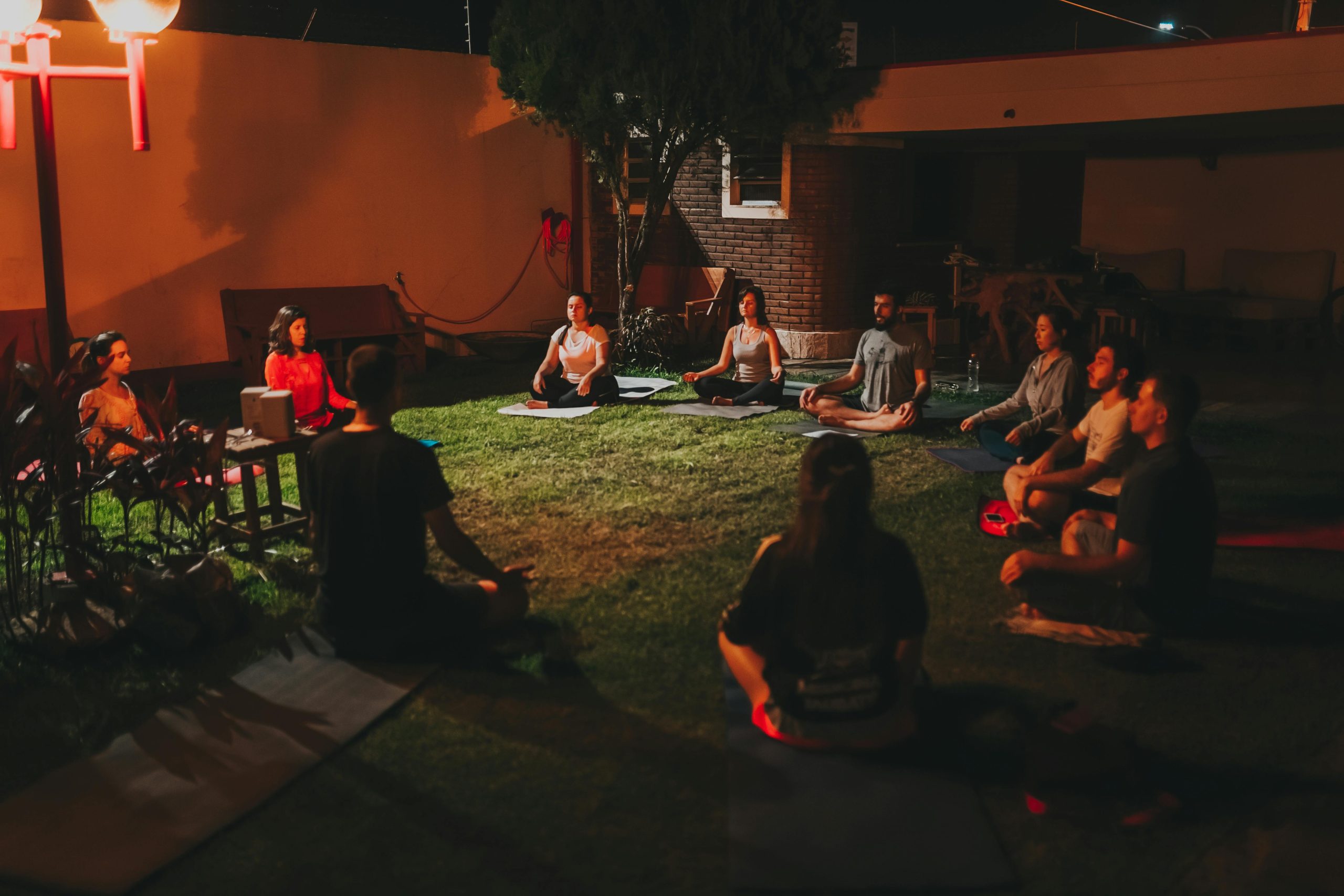Unraveling the Debate: Why Is Kundalini Yoga Deemed Dangerous?

Kundalini Yoga, often referred to as the “yoga of awareness,” purports to activate and balance the primal energy thought to be coiled at the base of the spine. The practice encompasses a blend of spiritual and physical activities involving movement, dynamic breathing techniques, meditation, and the chanting of mantras. Proponents believe these processes awaken the Kundalini energy and facilitate enlightenment. However, this deeply transformative journey has spurred a mosaic of opinions, and for some, it has led to experiences that have been described as dangerous, raising concerns about the practice’s safety.
One of the core debates hinges on the nature of the experiences encountered by practitioners of Kundalini Yoga. While many report profound and life-enhancing changes, others recount episodes of intense emotional upheaval, physical discomfort, or what’s often described as a “Kundalini awakening.” This involves a powerful surge of energy that some claim can lead to altered states of consciousness. Without proper guidance, these can manifest as overwhelming sensations and psychological disturbances, such as anxiety, confusion, or even psychosis in rare cases. Such potential risks have painted Kundalini Yoga with a controversial brush within certain circles.
The unique structure of Kundalini Yoga practice incorporates a variety of techniques that are said to purify the body’s energy systems. This might involve rapid, repetitive movements and breathwork that can be incredibly intense. The concern expressed by some healthcare professionals is that for individuals with underlying physical or mental health issues, such extreme techniques may exacerbate symptoms. Critics argue that the lack of standardized training for Kundalini Yoga instructors may contribute to the risks, with some teachers possibly ill-equipped to recognize or handle emergencies should they arise.
Subsequent discussions will pivot towards the narratives shared by individuals who have undergone what they perceive as Kundalini awakenings, contrasted with the perspectives of medical professionals and seasoned practitioners. By delving into these personal accounts and expert analyses, the conversation may illuminate how Kundalini Yoga practices intersect with mental health, physiology, and spiritual exploration. Further, the varying degrees of preparation and support provided to practitioners before, during, and after engaging in Kundalini Yoga will be evaluated against the backdrop of potential risks and rewards.
To ensure the discourse is not ensnared by the debate’s gravity, it will also touch upon cultural and historical contexts that have shaped the interpretation and practice of Kundalini Yoga in different communities. By interlacing anecdotal observations with scholarly research, the account becomes a tapestry that reveals the complexity of integrating ancient traditions into modern wellness paradigms. Thus, the narrative extends an invitation to a wider audience to understand the multifaceted implications of Kundalini Yoga, while withholding judgment, much like the very spirit of yoga suggests.
- Kundalini Yoga involves the awakening of energy at the base of the spine, which is said to ascend through the chakras, leading to spiritual enlightenment.
- Some practitioners and critics believe that Kundalini Yoga can be dangerous due to its intense physical and mental practices, which might overwhelm unprepared individuals.
- Reported dangers include psychological instability, psychosis, and physical injury if the exercises are not performed correctly under proper guidance.
- Detractors argue that the sudden release of Kundalini energy can lead to experiences that mimic psychiatric disorders, creating confusion and potential misdiagnosis.
- Supporters of Kundalini Yoga claim that when practiced responsibly and under the guidance of an experienced teacher, it is a safe and transformative discipline.
- It is recommended that individuals with a history of mental health issues consult with healthcare professionals before engaging in Kundalini Yoga practices.
- There is an emphasis on the importance of a gradual and respectful approach to Kundalini Yoga, allowing the body and mind to adapt to the heightened energy states.
- The debate on whether Kundalini Yoga is dangerous continues, indicating the need for more research and discussions on safe practice guidelines.
Is Kundalini Yoga Truly Dangerous?
Kundalini Yoga: A form of yoga that involves chanting, singing, breathing exercises, and repetitive poses. Its aim is to awaken the kundalini energy said to be located at the base of the spine.
Kundalini Awakening: This refers to the experience of awakening the kundalini energy, which is often described as a feeling of electric currents running along the spine.
Subtle Body: A term in various esoteric philosophies, referring to a series of psycho-spiritual constituents of living beings, composed of various layers of energy, rather than the physical body.
Chakras: According to some beliefs, chakras are various focal points in the subtle body used in a variety of ancient meditation practices, commonly Hindu, Buddhist, and Jain traditions.
Pranayama: The practice of breath control in yoga; considered important for cultivating energy, or prana, through breathing practices.
Kundalini Yoga, often referred to as the “yoga of awareness”, seeks to awaken the dormant kundalini energy at the base of the spine through a combination of postures (asanas), chanting, meditation, and breathwork (pranayama). The reason why is kundalini yoga dangerous can be considered is due to the intensity of the experiences associated with the awakening of kundalini energy. Practitioners sometimes report physical sensations like shaking, intense heat or cold, and energy surges, along with emotional upheavals, sensory distortions, and altered states of consciousness. These manifestations, often unexpected and powerful, can be concerning and potentially disturbing for unprepared individuals, leading some to view the practice as dangerous. Moreover, the deliberate attempt to manipulate this energy before the individual is ready or without proper guidance is another reason the practice has come under scrutiny.
Exploring Alternative Yoga Practices
Yoga, in its diverse forms, has been practiced for centuries to promote physical health and spiritual growth. Among the most widely embraced methods is Hatha Yoga, which focuses on physical postures, or asanas, combined with breath control, or pranayama. This ancient practice aims at balancing the mind, body, and spirit, leading to improved flexibility, strength, and relaxation. Participants often report a heightened sense of well-being after a Hatha Yoga session, which might include a sequence of poses ranging from the simple Mountain Pose to the more complex Headstand, each designed to enhance the body’s balance and core strength.
Teachers of Hatha Yoga emphasize alignment and slow transitions between postures, ensuring that practitioners of all levels can participate safely. The integration of mindfulness and breath awareness also cultivates a meditative component, allowing individuals to practice concentration and mental clarity. This wholeness approach makes Hatha Yoga not only a comprehensive exercise regimen but also a therapeutic tool that can assist in managing stress and anxiety.
The Benefits of Meditation and Mindfulness
Separate from the physical practice of yoga is the profound and introspective journey of meditation and mindfulness. These practices invite participants to delve into the quiet spaces of their minds, exploring the inner workings of their thoughts and emotions. Meditation often involves sitting in stillness, with a focus on a specific object, thought, or activity to train attention and awareness. Its goal is to achieve a mentally clear and emotionally calm and stable state.
Mindfulness, a complementary practice, encourages an attentive and non-judgmental awareness of the present moment. It can be incorporated into daily routines, allowing individuals to fully engage with their surroundings and experiences with a renewed perspective. A regular meditation and mindfulness practice has been linked to a multitude of health benefits, including reduced stress, alleviated symptoms of depression, enhanced cognitive function, and improved sleep quality. Moreover, these practices often serve as a foundation for greater emotional resilience and personal growth.
Introduction to Energy Work and Chakra Balancing
Beyond the physical and meditative realms of yoga, some delve into the world of energy work and chakra balancing. Rooted in ancient Indian philosophy, chakras are considered focal points of energy within the body, with each corresponding to specific organs and psychological aspects of one’s being. There are seven primary chakras, aligned along the spinal column, from the base of the spine to the crown of the head.
Chakra balancing involves various techniques aimed at harmonizing the body’s energy system, potentially leading to enhanced health and vitality. Practices may include guided visualization, chanting, color therapy, and the use of crystals or reiki healing. By focusing on balancing these energy centers, individuals aim to release blockages that can cause physical or emotional disturbances, pursuing a holistic path to wellness. While the effectiveness of chakra balancing is a subject of personal belief, many report improvements in their overall sense of harmony and vigor.
Dietary Practices and Ayurvedic Principles
Complementing yoga and meditation is the traditional Indian system of Ayurveda, which extends health and wellness practices into the realm of nutrition and diet. Ayurveda is founded on the principle that health results from the balance between mind, body, and environment and that this balance is mediated by one’s individual constitution, or dosha. Understanding one’s unique dosha—whether Vata, Pitta, or Kapha—can guide dietary choices and lifestyle changes that promote optimal health.
Ayurvedic diet regimens emphasize the consumption of whole, unprocessed foods, tailored to one’s dosha and the current season. Foods are categorized by their inherent qualities and the effects they have on the body; for instance, cooling foods are recommended for Pitta types, while warming foods may be better suited for Vata and Kapha constitutions. Ayurvedic principles also stress the importance of food combinations, eating sequences, and mindful eating practices. Those who follow these guidelines often note an improvement in digestion, energy levels, and a reduction in dietary-induced ailments.
1. What exactly is Kundalini Yoga, and why is it considered controversial?
Kundalini Yoga is a form of yoga that involves chanting, singing, breathing exercises, and repetitive poses. Its primary focus is on awakening the kundalini energy located at the base of the spine. This practice is deemed controversial due to its intense nature, which can lead to profound psychological effects and has sometimes been associated with symptoms like extreme emotional swings, altered states of consciousness, and even episodes resembling psychosis.
The controversy stems from the belief that awakening the kundalini energy before one is adequately prepared can result in negative experiences or harm. This view is contrasted by practitioners who argue that Kundalini Yoga is a powerful tool for personal growth and spiritual awakening, and that the risks are a natural part of the spiritual path and can be mitigated with proper guidance.
2. Are there any specific risks associated with practicing Kundalini Yoga?
Yes, there are specific risks associated with practicing Kundalini Yoga, especially when it is done without proper supervision or a thorough understanding of the practice. Some practitioners have reported experiencing intense and sometimes overwhelming energy surges, psychological discomfort, and physical symptoms such as shaking or involuntary movements. These experiences are often referred to as a ‘Kundalini awakening’, which can be troubling if one is not prepared.
In addition to the above, individuals with a history of mental health issues may find that Kundalini Yoga triggers or exacerbates their conditions due to the powerful emotional and energetic release it may catalyze. It is, therefore, important for individuals to approach Kundalini Yoga with caution, ideally under the guidance of an experienced teacher who can offer support and guidance through any adverse effects.
3. How can one practice Kundalini Yoga safely?
Practicing Kundalini Yoga safely involves several key considerations. Firstly, it is advised to learn with a certified Kundalini Yoga teacher who can provide proper instruction and support. Beginners should start slowly by gently introducing the practices and paying close attention to their body’s and mind’s responses. Adequate preparation, such as understanding the techniques and potential impacts, helps ensure a safer practice.
Additionally, maintaining a balanced lifestyle with a supportive community, having a personal meditation or mind-body practice, and ensuring good mental health can help mitigate potential risks. It is also recommended to avoid overexertion and to listen closely to one’s body and intuition, stopping if discomfort arises, and seeking professional help if negative symptoms persist.
4. Why do some people experience negative effects from Kundalini Yoga?
Negative effects from Kundalini Yoga may arise for a number of reasons. The practice is designed to release blockages and awaken dormant energy within the body, which can sometimes manifest as physical symptoms or intense emotions. Individuals may not be psychologically prepared for such experiences, leading to fear, confusion, or the surfacing of unresolved psychological issues. For some, this can be overwhelming and may manifest as negative effects.
Another factor is the lack of proper guidance; if practitioners attempt advanced techniques without adequate preparation or understanding, they may inadvertently trigger a forceful release of energy. Without the appropriate support system or coping strategies, this can result in negative experiences. A general lack of awareness about the potency of Kundalini Yoga can also contribute to experiences being perceived as negative when they might be part of a natural process of transformation and healing.
5. Can Kundalini Yoga have long-term negative effects?
While Kundalini Yoga is often practiced for its many benefits, there are reports of some individuals experiencing long-term negative effects, especially when the practices are not performed correctly or without appropriate support. These long-term effects can include ongoing psychological imbalance, persistent physical symptoms, and difficulty in managing daily activities due to the intensity of the experiences provoked by the practice.
It should be noted, however, that such long-term negative effects are not common and often relate to practices conducted without proper instruction or personal readiness. Most practitioners do not encounter severe or lasting complications, and many report positive life changes and improved well-being. The key to preventing long-term adverse effects is to approach the practice with care, respect, and proper guidance from experienced teachers.
6. How does one know if they’re ready to start practicing Kundalini Yoga?
Readiness for Kundalini Yoga is a personal matter and can depend on a variety of factors. Generally, an individual should have a stable physical and mental health foundation before embarking on this practice. It is beneficial to have some experience with other forms of yoga or meditation to build awareness and sensitivity to one’s body and mind. An honest self-assessment of one’s current state of health and well-being, coupled with consultation with a knowledgeable Kundalini Yoga teacher, can also guide the decision.
Furthermore, being open to the spiritual and emotional aspects of the practice is important. Kundalini Yoga includes elements that go beyond simple physical exercise, such as meditation, mantra chanting, and a focus on energy movement through the chakras. Individuals should have an interest in these dimensions and feel comfortable exploring them as part of their practice. Having a supportive environment and a commitment to self-care are additional factors to consider before starting.
7. What measures are advised if someone experiences overwhelming symptoms during Kundalini Yoga?
If someone experiences overwhelming symptoms during Kundalini Yoga, it is recommended to stop the practice immediately and seek a calm and safe environment. Breathing slowly and deeply can help regain equilibrium, as can grounding practices like walking barefoot on the earth or focusing on sensory experiences. Professional support from a healthcare provider, therapist, or experienced Kundalini Yoga instructor may also be necessary, especially if symptoms persist.
In addition, it may be helpful to engage in less intense forms of yoga or meditation to maintain a state of relaxation and stability. Sudden discontinuation of all practices is not always advisable as it can leave the individual without the tools to manage their symptoms. Communication with supportive friends, family, or community members who understand the nature of Kundalini Yoga can also provide reassurance and grounding during challenging times.
8. Is Kundalini Yoga suitable for beginners or those without prior yoga experience?
Kundalini Yoga can be suitable for beginners or those without prior yoga experience, but it is imperative to begin with classes specifically designed for beginners and under the instruction of a certified teacher. These classes typically introduce the foundational concepts and practices of Kundalini Yoga at a pace that is comfortable and safe for those who are new to the discipline. Beginner-level classes focus on building the practitioner’s awareness of their mind-body connection and understanding how to safely work with their energy.
Additionally, beginners should be clear about their intentions and any apprehensions they may have, as well as communicate openly with their instructor about their experience level. It is also sensible for beginners to inform the instructor of any health issues or concerns they might have so that the practices can be adapted accordingly. Patience and a willingness to pace oneself in accordance with one’s own readiness are crucial when approaching this powerful form of yoga for the first time.
9. Can Kundalini Yoga improve mental health despite the concerns?
Yes, Kundalini Yoga can improve mental health for many individuals despite the concerns raised about its safety. The key is to practice it responsibly and with awareness. The various techniques of Kundalini Yoga, including breathing exercises, meditation, and movement, can provide a framework for managing stress, reducing anxiety, and fostering a deeper sense of well-being. Many practitioners report increased clarity of mind, emotional resilience, and a heightened sense of connection to their inner selves.
It is also recognized for its potential to facilitate personal growth and self-discovery, which can contribute to improved mental health. However, for individuals with pre-existing mental health issues, it is recommended to practice under the supervision of a health professional and an experienced Kundalini Yoga instructor. This ensures the practice is tailored to the individual’s needs and provides adequate support, enabling them to experience the benefits while minimizing potential risks.
10. What should one look for in a Kundalini Yoga instructor to ensure a safe practice?
To ensure a safe practice of Kundalini Yoga, one should look for an instructor who is certified and has substantial experience with teaching Kundalini Yoga. Certification suggests that the instructor has undergone rigorous training in the philosophy, techniques, and ethical considerations of Kundalini Yoga. An experienced instructor will not only be able to help students perform practices correctly but can also offer guidance on how to navigate any challenging experiences that may arise.
Besides certification and experience, it is essential to find an instructor with whom one feels comfortable and supported. A good instructor should be approachable and willing to address students’ individual concerns, modify practices for varying skill levels, and offer constructive feedback. They should foster an environment of safety and inclusion, where students feel empowered to listen to their bodies and progress at their own pace. Engaging with an instructor who embodies these qualities can greatly enhance the safety and effectiveness of one’s Kundalini Yoga practice.
Final Thoughts
The debate surrounding why Kundalini Yoga is deemed dangerous often stems from its potent effects on physical, mental, and emotional levels. Critics argue that the intense practices aimed at awakening the Kundalini energy can lead to imbalances and potentially harmful psychological effects if not guided properly. As discussed, the risks may include the onset of a Kundalini Syndrome, characterized by a range of troubling symptoms like mood swings, hallucinations, and feelings of disorientation. Proponents, however, emphasize the transformative benefits, advocating the importance of a knowledgeable instructor to navigate such energies.
It’s clear that the practice requires respect for its depth and potential impact on the practitioner. The reasons why Kundalini Yoga may be dangerous hinge on the lack of understanding of the inner workings of the practice and the absence of proper guidance. With individuals seeking spiritual growth, the allure of quick advancement can overshadow the necessary foundation-building steps, potentially leading to adverse experiences.
Safety measures, like starting with a solid base in other yoga practices and progressing under the watchful eye of a seasoned teacher, are crucial. Addressing why Kundalini Yoga is dangerous, the consensus is that awareness and education are essential. Understanding and being prepared for its powerful effects can mitigate risks, ensuring that the path of Kundalini Yoga is traveled with wisdom and care.






